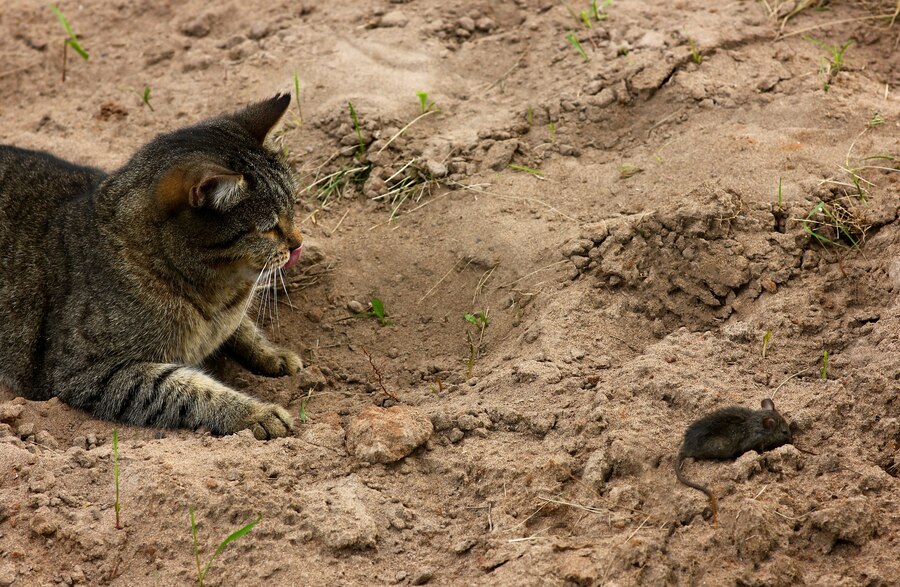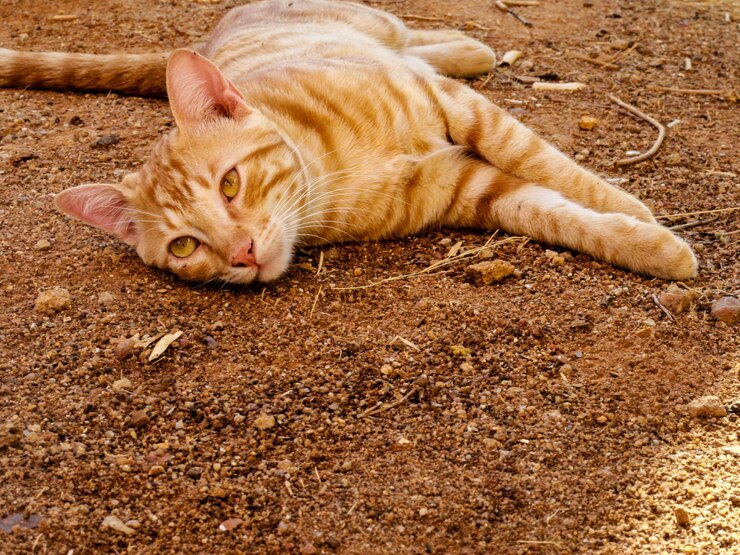Introduction
As a veterinarian, I often find myself addressing the myriad curious questions pet owners have about their feline companions. One of the most frequent and intriguing inquiries is: “Why do cats roll in dirt?” Despite their reputation for fastidious cleanliness, cats seem to derive immense joy from a good roll in the dirt. Understanding this behavior requires a look into their instincts, health benefits, and various other reasons. Let’s explore this fascinating aspect of feline behavior in depth.

What is Dust Bathing?
Dust bathing is a behavior observed in many animals including birds and mammals. This activity involves rolling or moving around in the dust or dirt and serves several purposes:
- Cleaning: Dust helps to remove excess oils and loose fur from the animal’s body.
- Parasite Control: The fine particles of dust can help dislodge parasites such as fleas and mites.
- Scent Marking: By rolling in the dirt, animals can spread their scent, marking their territory.
For cats, dust bathing is not just a whimsical activity. It fulfills multiple roles that contribute to their overall well-being. When your cat rolls in the dirt, it’s engaging in an instinctual behavior that serves both physical and psychological needs.
Why Does My Cat Roll In Dirt?
1. Do Cats Like Being Dirty?
While it might seem contradictory to their meticulous grooming habits, cats do appear to enjoy getting a bit dirty. Rolling in the dirt offers them a sensory experience that’s vastly different from their usual routines. The texture and temperature of the dirt provide a unique tactile sensation that can be both stimulating and pleasurable.
Anecdote: I once had a client with a Persian cat named Flown, who loved nothing more than to roll in the garden’s flowerbeds. Despite her luxurious, long fur, Flown would come back inside covered in dirt but visibly satisfied. Her owner learned to keep a brush handy to clean her up after these escapades, acknowledging that this was a small price to pay for Flown’s evident joy.

2. It’s Good For Their Gut
Interestingly, rolling in the dirt might have gastrointestinal benefits for cats. The ingestion of small amounts of dirt during these activities can introduce beneficial microbes into their digestive system. These microbes can aid in breaking down food and enhancing nutrient absorption.
Scientific Insight: Studies on various animals, including primates and some domestic pets, have shown that exposure to soil can help populate their gut microbiome with beneficial bacteria. For cats, this might translate into better digestion and overall gut health.
3. To Scratch Themselves
Cats often use rolling in the dirt as a way to scratch those hard-to-reach spots. The coarse texture of the ground provides an excellent surface to relieve itches and shed loose fur. If you’ve ever watched a cat roll around enthusiastically, you’ll notice they rub their backs and sides vigorously against the ground, clearly enjoying the scratchy sensation.
Veterinary Note: Many cats, especially those with longer fur, might find it challenging to groom every part of their body effectively. Rolling in the dirt helps dislodge loose fur and skin flakes, functioning as a natural grooming aid.
4. Territory Marking
Cats have scent glands located on various parts of their bodies, including their paws, cheeks, and flanks. Rolling in the dirt can help them spread their scent over a wider area, marking their territory. This behavior is particularly common in outdoor cats who need to assert their presence in a specific area. By leaving their scent behind, they communicate with other cats and animals about their territory.
Behavioral Insight: Territory marking through rolling can be especially prominent in multi-cat households or areas where many animals frequent. It’s their way of saying, “This is my space.”
5. Playing
Sometimes, rolling in the dirt is just plain fun for cats. They might be playing and entertaining themselves. This playful behavior can be observed more in younger cats and kittens, but even older cats enjoy a good roll now and then. It’s a way for them to let loose and enjoy themselves, much like how we might enjoy a game of catch or a romp in the park.
Personal Observation: I once observed a litter of kittens in a shelter. They would take turns rolling and pouncing in a patch of dirt in their play area. It was clear that this was an essential part of their playtime routine, contributing to their physical development and social bonding.
6. Trying to Cool Down
In hot weather, cats might roll in the dirt to cool off. The dirt can feel cool against their skin, providing relief from the heat. Additionally, by rolling in the dirt, they can create a layer of dust on their fur, which can help insulate them from the sun’s rays and keep them cooler.
Scientific Insight: The insulating layer of dust can also protect cats from extreme temperatures, much like how elephants use mud to cool down and protect their skin from the sun.

7. It’s a Response to Catnip
Catnip can trigger all sorts of fun and strange behaviors in cats, including rolling in the dirt. When cats ingest or smell catnip, they can become euphoric and engage in playful, hyperactive behaviors. Rolling around in the dirt is just one of the many ways they might express their catnip-induced joy.
Veterinary Note: The active compound in catnip, nepetalactone, affects the feline brain, creating a temporary state of bliss. This can manifest in behaviors such as rolling, purring, and playful antics.
8. Seeking Attention
Cats are smart creatures and often learn that certain behaviors can get them the attention they crave. If your cat notices that rolling in the dirt makes you pay attention to them, they might do it more often. It’s their way of saying, “Look at me! Aren’t I adorable?”
Anecdote: A patient of mine, a tabby named Oliver, would always roll on the driveway whenever his owner returned home. It was his special way of greeting and ensuring he got those extra pats and scratches.

9. Trying to Cover Up Its Scent
Rolling in the dirt might be a way for cats to cover up their own scent. This can be a survival instinct, especially for wild or feral cats. By masking their scent, they can avoid detection by predators or sneak up more effectively on their prey.
Behavioral Insight: In the wild, camouflaging their scent can be crucial for both predator and prey animals. Domesticated cats retain these instincts, showcasing the depth of their evolutionary traits.
10. To Aid Digestion
Similar to the earlier point about gut health, some experts believe that rolling in dirt can help with digestion. The dirt might contain minerals or microorganisms that aid in breaking down food and promoting a healthy digestive system.
Scientific Insight: Geophagia, the consumption of earth or soil-like substrates, is a behavior seen in many animals, including cats. This behavior can help in neutralizing toxins and aiding in digestion.
11. It’s a Mating Dance
During the mating season, you might notice an increase in rolling behavior, especially among female cats. Rolling can be a part of their mating ritual, signaling their availability to potential mates. It’s a way of spreading their scent and attracting attention from male cats.
Veterinary Note: Female cats in estrus, or heat, exhibit a range of behaviors aimed at attracting mates, including rolling and vocalizing. This behavior is often accompanied by purring and increased affectionate behavior.
12. Stress Relief
Just like humans, cats can get stressed. Rolling in the dirt can be a way for them to relieve stress and anxiety. The act of rolling can be soothing and calming, helping them to relax and feel more secure in their environment.
Anecdote: I recall a case of a stressed-out indoor cat named Luna. Her owners noticed she would roll in their backyard dirt patch whenever she felt anxious, particularly after loud thunderstorms. This behavior helped her calm down significantly.
Do Cats Love Rolling in the Dirt?
From my experience as a vet, it’s clear that many cats do enjoy rolling in the dirt. Whether it’s for play, comfort, or health reasons, this behavior seems to bring them a lot of joy. Watching a cat blissfully roll around in the dirt is a testament to how much they love this activity.
Personal Observation: My own cat, supi, despite having a plethora of toys and cozy spots indoors, never misses an opportunity to roll in the garden. It’s evident from his purrs and relaxed demeanor afterward that he finds it incredibly satisfying.
Should You Let Your Cat Roll in the Dirt?
Allowing your cat to roll in the dirt can have its benefits, but it also comes with some considerations. Outdoor environments expose cats to parasites, insects, and potential dangers like vehicles and predators. If you decide to let your cat enjoy the great outdoors, make sure they are supervised and up-to-date on their vaccinations and flea treatments.
Veterinary Advice: Regular check-ups and preventive care can mitigate many of the risks associated with outdoor exposure. Flea and tick preventatives, as well as regular deworming, are essential for outdoor cats.
How to Stop a Cat from Rolling in the Dirt
If you prefer to keep your cat clean and free from dirt, here are some strategies to discourage this behavior:
- Provide Alternatives: Create indoor play areas with scratching posts, toys, and even indoor cat grass. This can divert their attention from the outdoors.
- Use Cat Repellents: Certain scents, like citrus, can deter cats from specific areas. You can spray these scents in places where your cat tends to roll.
- Supervised Outdoor Time: If your cat enjoys the outdoors, consider supervised outings with a harness and leash. This way, they can enjoy the fresh air without getting too dirty.
- Regular Grooming: Keep your cat well-groomed to reduce the need for them to scratch and roll outside.
Anecdote: One of my clients successfully trained their cat, Leo, to stay within a specific outdoor enclosure. Leo still got to enjoy the feel of the dirt but in a controlled and safe environment, reducing his owner’s worry about parasites and other dangers.
Do Cats Need to Roll in the Dirt When They See You?
Cats are independent creatures, and their rolling behavior isn’t necessarily directed at you. However, if they notice that this behavior gets your attention, they might do it more often in your presence. It’s their way of engaging with you and showing that they feel safe and comfortable around you.
Behavioral Insight: Cats often use their behaviors to communicate with their humans. Rolling might be their way of showing trust and seeking interaction.
What Does It Mean When Your Cat Rolls in Your Dirty Clothes?
Cats are known to seek out their owner’s scent, and rolling in your dirty clothes is a way for them to feel closer to you. Your scent provides them with comfort and security, especially when you’re not around. It’s a sign of affection and trust.
Anecdote: I remember a case with a Siamese cat named Bella, who would always sleep on her owner’s gym clothes. The strong scent was reassuring to her, making her feel connected to her owner even when they were away.
Should You Let Your Cat Outside?
This is a decision that depends on various factors including your living environment, the personality of your cat, and potential dangers in your area. Outdoor time can provide mental and physical stimulation for your cat, but it also comes with risks. If you choose to let your cat outside, ensure they are safe and supervised.
Veterinary Advice: Consider building a ‘catio’—a cat patio. This enclosed outdoor space allows your cat to enjoy the outdoors safely. Regularly check for any signs of parasites or injuries and keep your cat’s vaccinations up to date.
Why is My Male Cat Rolling Around on the Floor?
Male cats, especially those that are not neutered, might roll around to mark their territory or signal their readiness to mate. Neutering your cat can reduce this behavior, as well as other marking behaviors like spraying.
Veterinary Note: Unneutered males are often more territorial and prone to displaying behaviors such as rolling, spraying, and aggressive posturing. Neutering can significantly reduce these behaviors and also prevent certain health issues.
Final Thoughts
Understanding why cats roll in the dirt can help us appreciate their behaviors and ensure their well-being. Whether it’s for play, health, or communication, this behavior is deeply rooted in their instincts. As a vet, I encourage pet owners to observe and understand their cat’s behaviors, providing them with a safe and enriching environment to thrive.
In conclusion, while it might seem odd to us, rolling in the dirt is a natural and enjoyable activity for cats. By understanding the reasons behind it, we can better cater to their needs and ensure they live happy, healthy lives.
The Fascination of Feline Behavior
Cats are enigmatic creatures with behaviors that often mystify us. Yet, each quirky action is a window into their ancient instincts and modern adaptations. Rolling in the dirt, though seemingly simple, is a complex behavior with multifaceted reasons. Embracing and understanding these behaviors enriches our bond with our feline companions, making every dirt-speckled roll an opportunity to connect more deeply with them.
Closing Anecdote: Reflecting on my years as a vet, one story stands out. A cat named Shadow, who was initially a stray, adopted by a loving family. Despite becoming an indoor cat, Shadow would always find the potted plants indoors and roll in the soil. His owners, rather than scolding him, embraced this quirk, placing larger pots and providing a small indoor dirt patch for him. This simple act of understanding and acceptance led to a happier, healthier Shadow and a stronger bond with his family.
By viewing our cats’ behaviors with curiosity and empathy, we can better cater to their needs and create a harmonious home where they can thrive.


